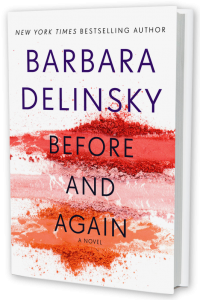How to Write Like Delinsky: Five Rules Of Writing
 Some things are ingrained from childhood. One of those, for me, is the start of the school year. New clothes, new books, new classes, new rules – I may have outgrown the first three, but the part about rules never leaves. So I start off the 2018-2019 learning year with FIVE Rules of Writing.
Some things are ingrained from childhood. One of those, for me, is the start of the school year. New clothes, new books, new classes, new rules – I may have outgrown the first three, but the part about rules never leaves. So I start off the 2018-2019 learning year with FIVE Rules of Writing.
If you think they’re just for you, think again. I’m heavily into writing my next book, so they’re absolutely for me, too.
-
DO YOUR HOMEWORK
The old rule of thumb is to write what you know, which is fine and dandy until you’ve written a dozen books and “what you know” is feeling used up. At that point, you turn to something new and quickly realize that writing “what you know” is a cinch by comparison. I have faced this situation dozens of times, and while I do fall back on the familiar every few books, like photography, there has to be more.
The key? Research. No, no. Don’t moan and groan. We’re long past the days when research had to be done in the library or, worse, by snail mail. Now it’s about googling, reading blogs, and emailing resources. I’ve learned about raising Angora rabbits, designing a home, sculpting a teapot. I’ve learned about health issues, like MS, infertility, brain injury, and Alzheimer’s. For my current book, I’m researching beach erosion and the life of a veterinarian.
Yes, that’s researching, present tense. It’s important to research major elements before you start to write since the results of what you learn can impact your plot. But as new things crop up in the course of the writing, as they have in my WIP, I do more research. Just remember. Make a mistake, and some reader out there will catch you, no matter how many disclaimers are in your Acknowledgement page.
-
CREATE LIKEABLE CHARACTERS
The reader has to want to read on, and for that, she has to care. Creating characters who are likeable can make that happen. When I think back on books I’ve read in the last year and hated – even audiobooks I’ve started and then actually returned – it’s because I found the main characters so unpleasant that I couldn’t have cared less. To the contrary, put a sympathetic character in an untenable position, and the reader is hooked.
Please don’t misunderstand me. Main characters shouldn’t be perfect. We identify with them far more if they’re flawed, since we’re flawed, too. But there’s sweet, quirky, or shy, and absent-minded, severely near-sighted, or logic-challenged, any of which can be endearing. There’s nothing more addictive than being introduced to a character we like and then having the author pit that character against an enemy.
There’s a fine line between a sympathetic and annoying. Occasionally, I’ve crossed it without meaning to. This happened with Sweet Salt Air, which was wildly successful in its final form but might not have been if the first draft had gone into print. Of the two friends around whom the story is told, Charlotte is one who made a moral faux pas years before, but Nicole was the one my editors disliked. She was too self-absorbed, too small-minded, they said. And they were right.
So I went back and altered her character at the get-go. That allowed me to give her moments of self-absorption and smallness, but the readers liked her. I needed to have the reader care enough about Nicole, warts and all, to keep reading.
-
GIVE EACH SCENE A PURPOSE
I recently read a book where the only purpose of several lengthy passages was to showcase the authors’ exquisite prose. And that’s fine if that’s what your readers want. Mine do not. I’ve written scenes that I thought were brilliant in a literary sense, only to realize that they lacked purpose and were instead a distraction that broke the momentum and diluted the plot.
How to avoid this? Part of it can be done at the planning stage. As I plot the general course of the book, I list scenes that will move the plot forward. The greater part, though, has to be done as I write. At the end of a work day, as I reread, I try to be critical. If what I’ve written doesn’t add something to the book, it has to go.
Cutting is painful. Deleting what you’ve sweated to create is every writer’s nightmare. But it matters. Take Family Tree. Only after I’d finished writing the whole thing did I realize that several chapters were superfluous. My editor agreed. I deleted whole chapters. The entire manuscript actually went from 450 pages to 350. And the book is stronger for it.
So please. Don’t waste the reader’s time. Make each chapter count. A reader who skims is a reader who will not buy your next book.
-
MAKE IT MOVE
This is about speed, rather than content, as in the point above. It’s about pacing. Your plot has to go somewhere, and it has to go there in a timely fashion. Today’s reader is used to non-stop, heart-thumping speed. A suspense novel offers that, which perhaps accounts for the rise of the Gone Girl genre.
But my books aren’t suspense novels. They are emotional family dramas, and family dramas can unfold in ways that are slow and cerebral and dense. That said, if I want to attract a larger audience, even some of those women who also like thrillers, my plot has to move.
Two things can help. First, a vehicle to carry the plot along. Take Before And Again. The plot centers on a woman who has lost a child and is trying to move on with her life, only to have the past keep popping up when she least expects it. This book has a main character, her mother, her brother, and her ex-husband, plus lots of anguished discussions with each.
But I needed a vehicle. So I gave my protagonist a friend with a legal issue that involved media attention. Legal issues allow for reveals at pivotal moments. Hence, my vehicle.
Second, a cliff-hanger … or twenty. I’m actually going to devote an entire blog to this, so if you’re interested, check back in another week or two. But the issue here, really, is where to end a chapter. I love it when readers comment that they couldn’t put my book down. Part of that is because I end a chapter in a way that raises a new question that can only be answered by moving right on to the next chapter.
-
EDIT FOREVER
Well, maybe not forever, but certainly either until you know that what you have is the best you can possibly do, or until you run out of time. I started writing when an electric typewriter was state of the art. Now, with computers making adjustments and improvements easy, there is no excuse not to do it.
And it’s constant. There is no first draft or second draft. If a draft counts each time I make a significant change, I do hundreds of drafts for each book.
What do I edit?
Words, sentences, paragraphs. I may not be a wizard of literary prose, but I like what I write to have rhythm. When I first started writing, I attended a signing for a favorite author. When I finally reached the head of the line and gave the author my book to sign, I told her that I loved her work because it flowed. I’m not sure she understood what I meant. I suspect she was just thinking about how much longer she had to stay.
But the flow of that author’s words was a model to me that I follow to this day. When I edit, I go for flow.
I edit to streamline. Why use three adjectives when one is far more effective? Of course, that one has to say it right, so I edit it until I like the one I have.
I edit to correct typos. And even then readers catch a few.
I edit to eliminate repetition. Maybe it’s just a pet peeve of mine, but I hate reading a book in which events are repeated each time a character talks with a different person. The author (me!) may not realize it’s happened until she rereads the whole book.
I edit for inconsistencies in the spelling of names, eye color, chronology. Granted, I have a copy editor whose job is catching these, but for me, it’s a matter of pride to turn in the best-looking manuscript.
I edit for slow parts, as per #s 3 and 4 above. One thing I’ve learned over the years is that if I’m bored, my reader will be, too. The only yawns I want are from readers who are absolutely exhausted because it’s the wee hours of the morning, and they can’t put my book down.
There you go, my FIVE Rules of Writing.
Do you follow any of them when you write an email or a text? If you’re a writer, do you have any to add?
Connect with me on social media: Twitter, Facebook, my new Street Team (click to join for fun, exclusive things I’m dreaming up), Pinterest, Instagram, and that’s it for now. I need time to write my books!
Before and Again is now available everywhere. Click here to purchase! 

If you’d like to read more of Barbara’s book reviews, sign up for her newsletter here. You can also find her on Instagram where she frequently shares photos of her photography, family, and travels.
Want an insider peek to all things writing? Join her street team!

You’re one of my favorite writers, and reading how your form your own stories is insightful and helpful. I’m working on my third WIP, I’m unpublished, but I found reading your tips helpful. I’m always editing. And even if I’ve finished a scene, I back track on information, to make sure that its accurate. As an aspiring writer, thank you for sharing your knowledge and tips. Can’t wait to read more.
Thanks for your note, Tina. Every writer does it a little differently, but I do hope these help. Good luck with your work!
I just recently discovered your books Barbara, and I am just thrilled I have. I like that they are set in New England, how the stories just flow and keep one interested. Keep on writing and I will keep on reading.
Will do, Betsy!
Good explanations for each of your rules, Barbara. A likeable but interesting character can be tricky but worth crafting.
That’s the challenge. Without it, I’d likely be bored.
I really like the advice you’ve given. I truly believe these are golden rules every writer should live by.
Feel free to share them, Kenya .
I went away to school purposefully to learn what is your rule number one. I felt I was way too inexperienced to write, not realising that “what I know” could be researched as well as lived. Literary Criticism opened my eyes to literature without instructing me how literature was built by the author. It was all hindsight rather than foresight for me until much, much later in life. By the time I read your rule number one, I had discovered it on my own. I wish I had known about it back in ’88 when I went to school. It would have changed my life in so many ways. For all the future thick-headed young writers, like I was, thank you for stating the obvious clearly. Sometimes that needs to be done, and rule number one has become as important as the physical act of writing to me now.
Well, you do write beautifully. Good luck with your work!
Thank you very much for your kind encouragement.
[…] Previous My Take on Brett Kavanaugh, Christine Blasey Ford, and The Supreme Court […]
Happy holidays to you and your family. I have read your books since 1990 when I lived in DC for about 2 years. They got to me right away. Your plots, the persons, the places you choose to have. Also when you go back and forth and connect like in Flirting with Pete. I really liked that plot.
I have not found your newest book here in Iceland yet. I just may have to order it.
Sometimes when I need something familiar I pick up few of your older books, rerread them again….. like many times or browse through them.
Keep on writing. Your words nakes me feel food.
Best regards from Iceland 🎄🎁😉
Sorry about the last sentence. I truly meant that your words makes mee feel good 😂😁😁
I love these tips. You and Pat Conroy are the authors who most keenly inspire me to write. Thank you for paving the way, by example, to having three books published by Harper Collins!
Congrats to you on those publications, Michele. I love being an inspiration. That said, another writer once told me that successful writing is 1% inspiration and 99% perspiration. So kudos for you for doing all the hard work!
Love your books! Also love that rule 6 is noted.. no modern names in novels set long ago! Total turn off…So thanks for keeping things fun, engaging , accurate and realistic!!! You keep that up and I’ll keep helping you pay your power bill. 👍🏻
Its superb as your other posts :D, thank
you for posting.
[…] Not so long ago, the time spent in this would have made me nervous. After all, I had to shower, eat breakfast, and return to work – because, seriously, I had a schedule to maintain. […]
[…] you search the web for bits of information? I’m constantly doing it for work. Take […]